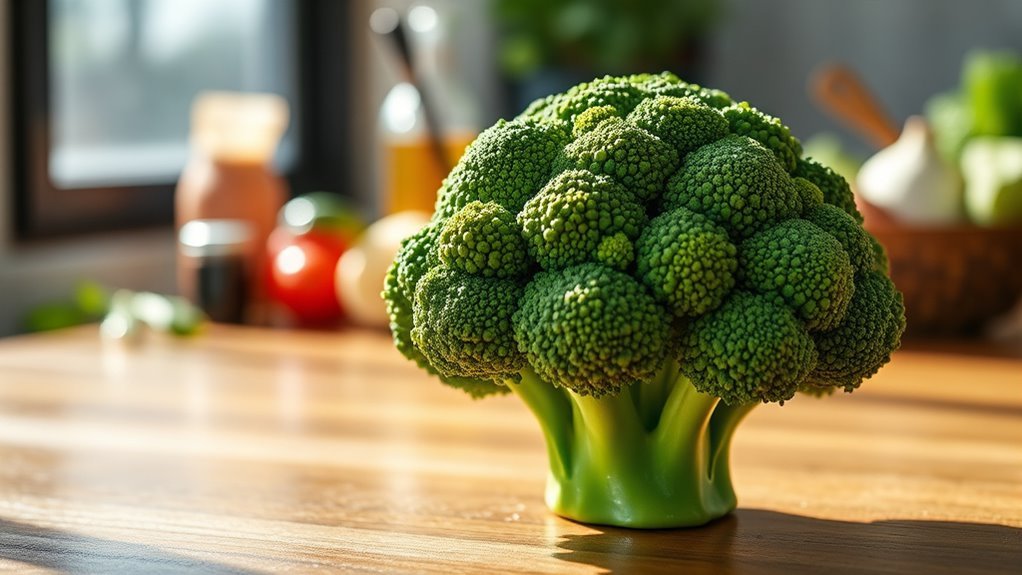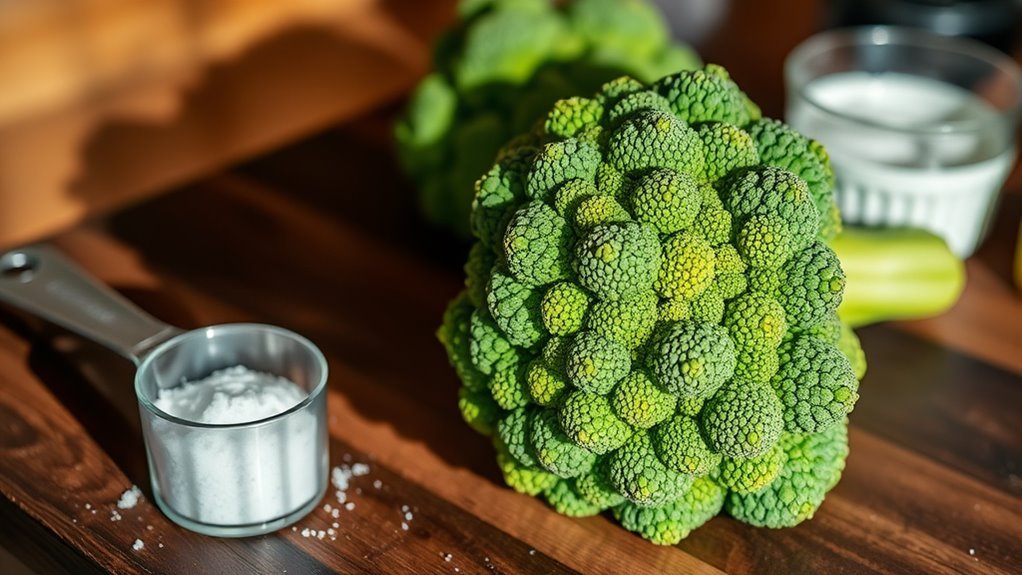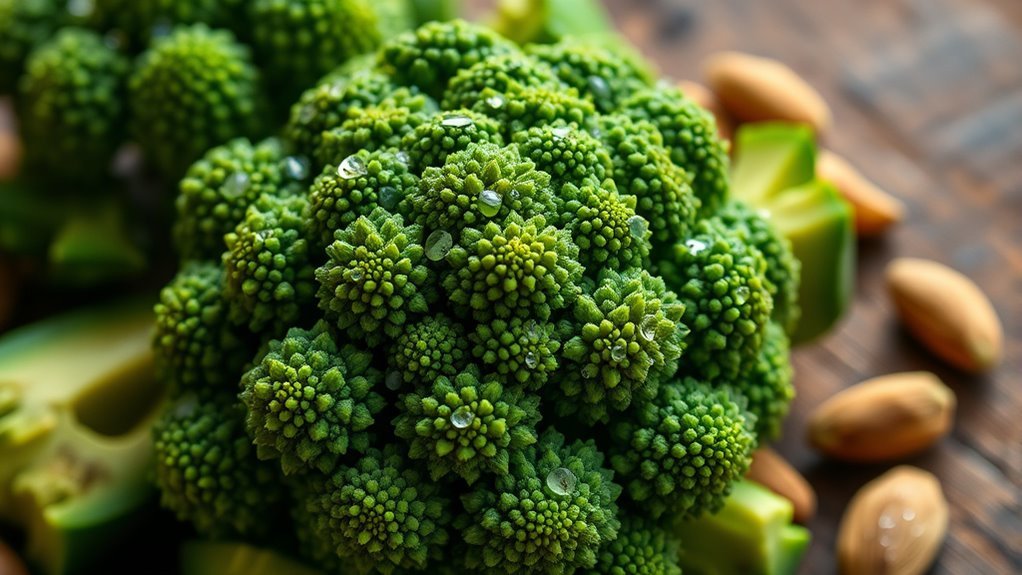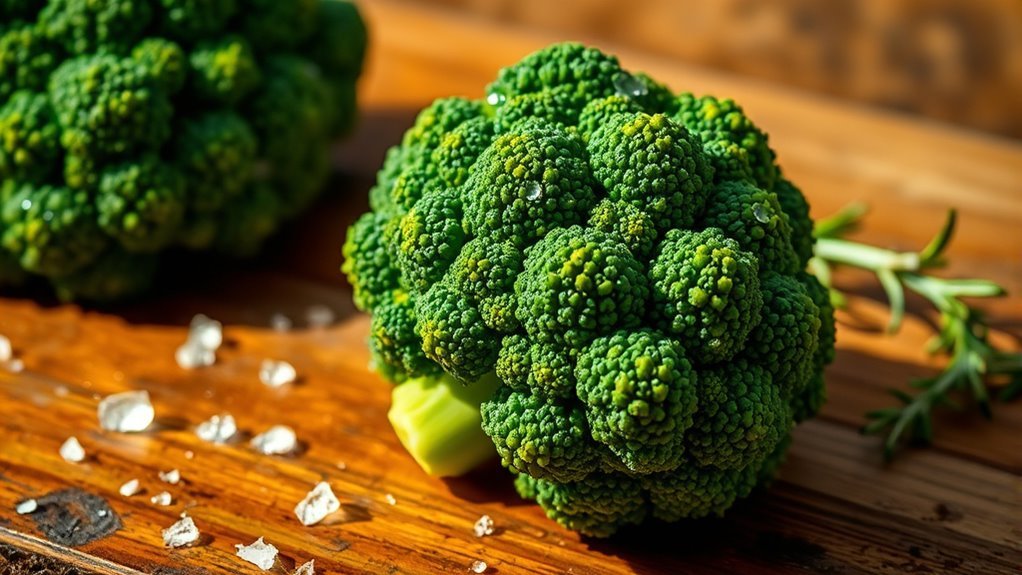Yes, broccoli is keto-friendly! It’s low in carbs, containing about 4 grams per 100 grams, with just 1.4 grams of net carbs after fiber. This cruciferous vegetable is packed with vitamins, minerals, and antioxidants, making it a nutritious choice for your diet. Plus, its high fiber content aids digestion and promotes satiety. You can enjoy it in various keto recipes. There’s even more to learn about its health benefits and ways to incorporate it into your meals.
Nutritional Profile of Broccoli

Broccoli, often hailed as a superfood, boasts an impressive nutritional profile that aligns well with a ketogenic diet. It’s packed with vitamins C, K, and A, along with essential minerals like potassium and manganese. The nutritional density of broccoli means you’re getting a wealth of nutrients without a lot of calories, making it a fantastic choice for anyone seeking to optimize their health while enjoying freedom from restrictive eating. Plus, its high fiber content aids digestion and helps you feel fuller longer, further supporting your keto goals. Incorporating broccoli into your meals not only enhances flavor but also provides numerous broccoli benefits, like reducing inflammation and boosting antioxidant levels. It’s a small way to make a big impact on your diet.
Carb Count in Broccoli

When it comes to carb count, broccoli is a standout vegetable for those following a keto diet. With just about 4 grams of carbs per 100 grams, it’s an excellent choice for maintaining ketosis. Plus, the fiber content, around 2.6 grams, means your net carbs are only about 1.4 grams per serving. This low broccoli carb count makes it highly compatible with keto principles, allowing you to enjoy it without compromising your daily carbohydrate limits. You can incorporate broccoli into various meals, from stir-fries to salads, enhancing flavor while keeping your carb intake in check. Its versatility and nutritional density make it not just keto-friendly but a wise addition to any low-carb lifestyle. Enjoy the freedom to indulge!
Health Benefits of Broccoli

In addition to its low carb count, broccoli offers a wealth of health benefits that can enhance your overall well-being. Packed with broccoli antioxidants, it helps combat oxidative stress and supports your immune system. Plus, its anti-inflammatory properties may reduce your risk of chronic diseases.
Here’s a quick look at some of broccoli’s key benefits:
| Health Benefit | Description |
|---|---|
| Antioxidant Rich | Fights free radicals and boosts immunity |
| Anti-Inflammatory | Reduces inflammation in the body |
| Nutrient Dense | High in vitamins C, K, and fiber |
| Heart Health | Supports cardiovascular function |
| Bone Health | Provides essential nutrients for bones |
Incorporating broccoli into your diet can be a simple yet powerful way to improve your health.
Incorporating Broccoli Into a Keto Diet
While many vegetables can be high in carbohydrates, incorporating broccoli into your keto diet is a smart choice due to its low carb content and versatile nature. You can enjoy broccoli in various ways, making it easy to fit into your meals. Consider adding it to your favorite broccoli salads for a invigorating crunch or blending it into delicious broccoli smoothies for a nutrient-packed drink. This vegetable’s fiber content also helps keep you full, making it a great option for snacking. Plus, broccoli’s rich vitamins and minerals support overall health, helping you maintain your energy levels while staying in ketosis. Embrace broccoli’s versatility, and you’ll find it becomes a staple in your keto-friendly meals.
Cooking Methods for Keto-Friendly Broccoli
Although broccoli is naturally low in carbs, the way you cook it can considerably impact its nutritional profile and flavor. Employing proper cooking methods is essential for a keto-friendly diet. Here are some recommended techniques:
| Cooking Method | Benefits |
|---|---|
| Steaming Techniques | Retains nutrients and flavor |
| Roasting Methods | Enhances sweetness and texture |
| Stir-Frying | Quick cooking preserves crunch |
| Blanching | Brightens color and flavor |
| Microwaving | Fast and nutrient-preserving |
Broccoli Recipes for Keto Meal Planning
Cooking methods can considerably elevate the flavor and nutritional value of broccoli, making it a versatile ingredient for your keto meal planning. One delicious option is a broccoli stir fry. Toss bite-sized florets with your choice of protein, like chicken or tofu, and a low-carb soy sauce for a quick, satisfying meal. For a creamy broccoli dish, sauté the florets in butter, then add heavy cream and cheese, creating a rich side that pairs well with any protein. You can also roast broccoli with olive oil and garlic for a crunchy snack or side dish. These recipes not only keep your meals exciting but also help you stay on track with your keto lifestyle. Enjoy the freedom of creativity in your kitchen!
Other Low-Carb Vegetables to Consider
When considering low-carb vegetables, leafy greens like spinach and kale are excellent options that provide essential nutrients with minimal carbs. Cruciferous vegetables such as cauliflower and Brussels sprouts also fit well within a keto diet, offering versatility in meals. Incorporating these vegetables can enhance your diet while keeping carb counts low.
Leafy Greens Options
While broccoli is a popular choice for those on a keto diet, there are plenty of other leafy greens and low-carb vegetables you can include in your meals. These options not only add variety but also come with impressive nutrition benefits. Here are three great alternatives:
- Spinach: Packed with vitamins A, C, and K, spinach is low in carbs and high in antioxidants, making it a perfect keto-friendly choice.
- Kale: This nutrient-dense leafy green offers fiber and essential minerals, helping you stay satisfied while keeping carb counts low.
- Swiss Chard: Rich in magnesium and potassium, Swiss chard is another excellent option that can be easily incorporated into salads or stir-fries.
Explore these leafy greens to enrich your keto meals and enjoy the freedom of diverse flavors!
Cruciferous Vegetable Choices
Leafy greens aren’t the only vegetables that fit well into a keto diet; cruciferous vegetables also offer fantastic low-carb options. These veggies, including various broccoli varieties, are nutrient-dense and low in carbs, making them perfect for your keto journey. Not only do they provide essential vitamins and minerals, but they also boast unique cruciferous benefits, such as promoting gut health and reducing inflammation. Here are some top choices to take into account:
| Vegetable | Net Carbs (per 100g) |
|---|---|
| Broccoli | 4g |
| Cauliflower | 3g |
| Brussels Sprouts | 6g |
| Kale | 4g |
| Cabbage | 3g |
Incorporating these options can enhance your meals while keeping carbs low.
Tips for Buying and Storing Broccoli
When you’re buying broccoli, look for vibrant green color and firm stems to guarantee freshness. Proper storage techniques, like keeping it in a breathable bag in the fridge, can help maintain its crispness. If you want to extend its shelf life even further, consider freezing it after blanching to preserve its nutrients.
Choosing Fresh Broccoli
To guarantee you’re getting the best quality broccoli, it’s essential to know what to look for when buying and storing this nutritious vegetable. Start by choosing a fresh selection that’s vibrant in color and firm to the touch. Keep an eye out for seasonal availability, as fresh broccoli is often at its best in cooler months. Here are three tips to help you select the finest broccoli:
- Look for tight, compact florets without yellowing or wilting.
- Check the stems; they should be firm, not soft or dried out.
- Choose broccoli with a strong, fresh aroma rather than a bland or unpleasant smell.
Proper Storage Techniques
Once you’ve selected fresh broccoli, how you store it can greatly impact its quality and shelf life. For ideal freshness, you’ll want to maintain proper refrigeration. Store broccoli in the vegetable crisper drawer of your fridge, where the temperature is cooler and more consistent. To achieve optimal humidity, place your broccoli in a perforated plastic bag. This allows for airflow while retaining moisture, preventing wilting. Avoid washing it before storage, as excess moisture can lead to spoilage. Instead, wash it right before you’re ready to use it. By following these simple storage techniques, you can keep your broccoli fresh longer, ensuring you always have this keto-friendly vegetable ready for your meals.
Freezing for Longevity
If you’re looking to extend the shelf life of your broccoli, freezing is a great option that preserves its nutritional value and flavor. To guarantee your broccoli remains fresh and tasty, follow these simple steps using effective freezing techniques:
- Blanching Broccoli: Start by blanching your broccoli in boiling water for 2-3 minutes. This process helps maintain color, texture, and nutrients.
- Cooling Quickly: After blanching, immediately transfer the broccoli to an ice bath. This stops the cooking process and locks in freshness.
- Proper Storage: Once cooled, drain and pat dry the broccoli. Place it in airtight freezer bags, removing as much air as possible before sealing.


